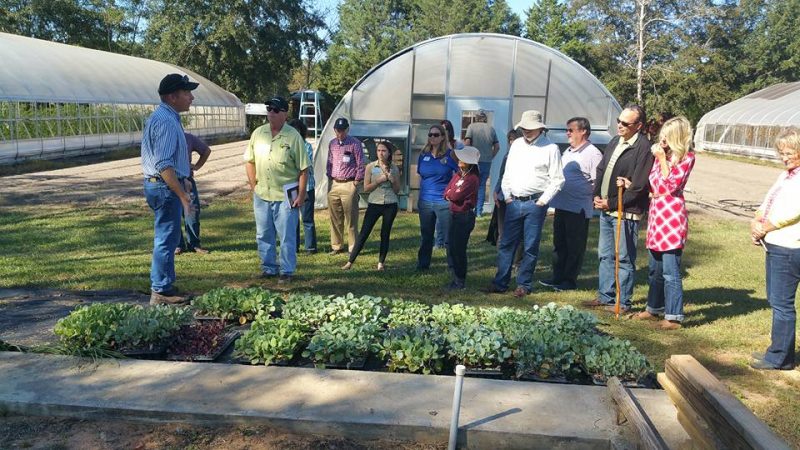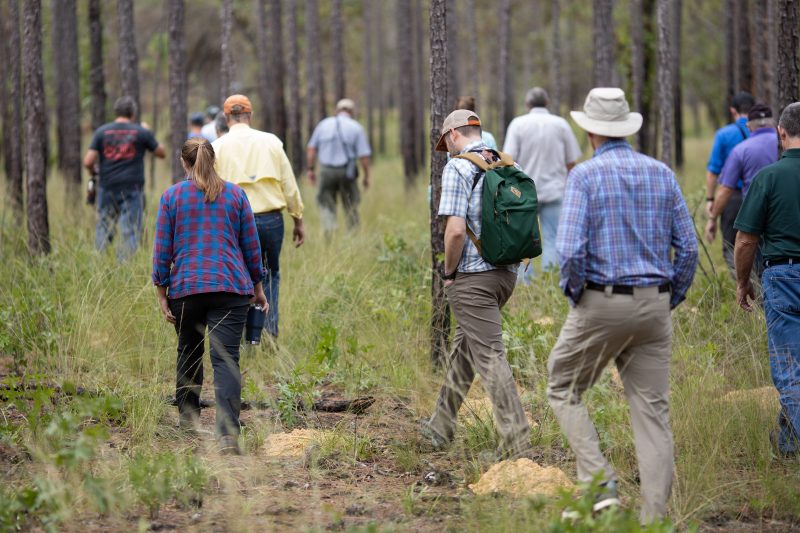I recently attended the North American Farmers’ Direct Marketing Association Agritourism Convention and Expo. That’s quite a mouthful, so the association uses the acronym NAFDMA. During the convention, I attended a number of talks that focused on event planning. Hosting on farm events isn’t for everyone, but if you’ve ever considered it, you may find the following tips helpful.

Participants of the Protected Agriculture Tour visited the Fox Family Farm in Cottondale, Florida. Photo Credit: Libbie Johnson, UF/IFAS.
–
Event Timing and Duration
Many of the farms represented at the convention host holiday themed events such as Easter egg hunts, picture opportunities with Santa, and Mothers Day flower cuttings. For these holidays in particular, you probably won’t schedule the event for the date of the holiday, but you will need to consider what day(s) and times you’ll be open for the event. You may even consider scheduling your event for multiple days to make it available for more customers, and even to allow some customers to visit the farm more than once. Opening events up for more than one day can also reduce issues with parking congestion and big crowds. Not only should you consider how many days your farm will be open for a specific event, but you should also think about your hours of operation. When considering hours of operation for a single event, you should think about the time it takes for the average visitor to drive to your farm. If your target audience is driving in from a city or large town, then take travel time into consideration when planning activity times. A good rule of thumb is to have drive time equal time spent on the farm. For example, if you’re hosting an Easter event that includes an egg hunt, a face painting table, and food vendors then you should schedule roughly the amount of time to complete all these events to equal the amount of drive time for your average visitor. If your average visitor is driving an hour to get to your farm, then the total time allotted for activities should equal about two hours. This will give your visitors two hours of drive time and two hours of time on the farm.
–
Advertising and Funding
We live in a world with a plethora of advertising platforms and outlets. You should consider your target audience when choosing how you advertise. Without getting into an in-depth discussion on generational differences, we can make a few assumptions. The first assumption is that most people use Facebook whether they admit to it or not. Teenagers may use it to keep tabs on their parents and their parents may use it to buy stuff they don’t need and share corny jokes. But the fact of the matter is that it’s a platform that gets a lot of traffic, and you can use it to advertise for free or reach a broader audience for a fee. Studies have shown that YouTube is used by all ages too. However, my assumption on YouTube is that most people use it to learn how to do something or watch an episode of their favorite childhood show. The point is, if you don’t want to put in the time and effort to create consistently funny videos about your farm, then YouTube probably isn’t going to be the best marketing venue. A number of the farmers at the convention still use radio advertisements. They said they prefer this method because they can target specific audiences, based on the station, and it’s not that expensive. They even mentioned making contacts at local radio stations to advertise in person during scheduled talk shows.
In addition to using your own money for advertising, you may want to consider grant opportunities. Some county and city governments offer grant opportunities through tourism dollars. For example, the Santa Rosa County Tourism Development Office sets aside a portion of lodging taxes collected each year and offers it to businesses to help fund advertising efforts for events that attract overnight visitors. The grant funds are advertised at the first of the year and require a simple application process for potential eligibility. It would be wise to research if this sort of program is available in your area.
–
Keeping People Entertained and Happy
One thing that can always make people happy is good food. It can also leave customers underwhelmed if it’s not good. Selling prepared food requires a permit and inspection from the Florida Department of Agriculture and Consumer Services (FDACS). More information on food establishment requirements can be found at the FDACS Food Establishments Page. One tip for making a profit on selling food is to keep your food costs to 20% or less of the items’ menu costs. Preparing and serving food takes time and labor away from other activities on the farm, so you may choose to invite a food vendor or multiple food vendors to your farm for special events. In this case, make sure you contract with reliable and trusted vendors.
Most people don’t like to be idle. Especially when they take the time to travel to an event. It’s important to keep people entertained from the moment they arrive at the farm. Depending on the event, you may consider installing some different games and activities to keep customers active. Some of the classics include slides, swings, and photo opportunities/stations. A couple of my favorites from the convention were axe throwing stations and human billiards. It doesn’t take much to paint a target on a board and charge people to throw hatchets at it. However, it’s suggested you review your event insurance policy to determine if you need to make modifications before installing an axe throwing wall. Human billiards is pretty much what it sounds like. A rectangular billiard table can be constructed on flat ground with landscape timbers, 4x4s, or railroad ties. 5-gallon buckets are buried in the ground to create the pockets and colored and striped soccer balls can be purchased to serve as the billiard balls. The people playing the game serve as the cues.
These are just a few tips for hosting events on your farm. Make sure to conduct diligent research before hosting people on your farm. For more information and ideas check out the article “Creating and Hosting Events at Your Agribusiness”. You may also want to connect with the Florida Agritourism Association and the FDACS Division of Marketing and Development.
- Benefits of Manure Fertilizers and Analysis - March 21, 2025
- Mushrooms – A Crop Worth Consideration for the Back Forty - October 4, 2024
- Hosting an On Farm Agritourism Event: Helpful Tips - February 16, 2024

